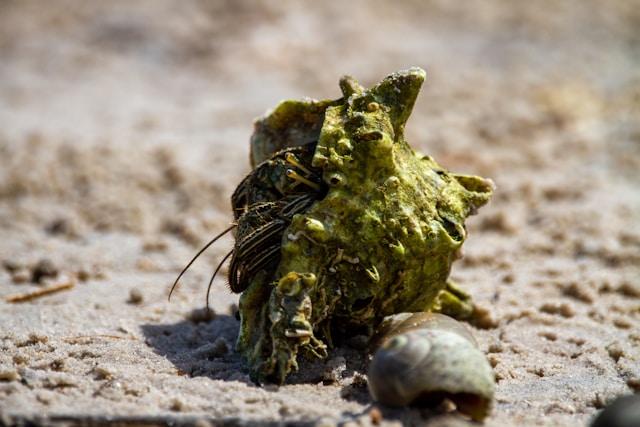How Hermit crab shells are made? 4 secrets of their shells

Beachgoers and ocean lovers alike are fascinated by hermit crabs, the inquisitive little critters that roam the shores. These already interesting crustaceans are made even more interesting by their strange habit of living inside abandoned shells and carrying their homes on their backs.
However, have you ever considered the intricate process involved in making these shells? Discover four hidden facts about the structure of hermit crab shells as you explore their world further.
Building Blocks: The Ingredients Behind Hermit Crab Shells
Hermit crab shells are primarily made from a combination of four main ingredients or products:
1. Calcium Carbonate: This mineral compound is the basic building block of hermit crab shells. Hermit crabs extract calcium carbonate from their environment and excrete it through glands in their excreta. Once secreted, the calcium carbonate hardens over time, forming a strong outer shell that protects and supports the crab’s soft body.
2. Protein: Along with calcium carbonate, protein plays an important role in the formation of the shell of the hermit crab. Proteins act as binding agents, helping to strengthen the shell’s structure and provide flexibility. They also contribute to the overall stability and resilience of the shell, ensuring that it can withstand the rigors of the crab’s environment.
3. Chitin: Chitin is a tough, fibrous substance that makes up the bulk of their exoskeleton. It provides strength and structure to the shell, serving as a framework for the deposition of calcium carbonate and other minerals. Chitin also helps to regulate moisture levels inside the shell, prevent dehydration and maintain an optimal environment for the crab’s body.
4. Trace Minerals: In addition to calcium carbonate, protein and chitin, hermit crab shells may contain trace amounts of other minerals and elements. These include magnesium, potassium, sodium, and phosphorus, which contribute to the overall structure and properties of the shell. While present in small amounts, these trace minerals play an important role in maintaining the integrity and functionality of the shell.
Together, these four ingredients form the base of the hermit crab shell, providing the necessary structure, strength, and protection for these fascinating crustaceans.
Seeking Refuge: The Beginning of a Hermit Crab
Let’s first examine the reasons behind their need for shelter in the first place before delving into the mystery of shell production. Hermit crabs, like all other organisms, have survival needs, one of which is defense against predators and adverse environmental factors. However, hermit crabs do not have a hard, calcified exoskeleton to protect their delicate bodies like other crustaceans. As a result, they use recycled shells as mobile homes, a tactic that has been perfected over millions of years.

Secret Armor: The Role of Calcium Carbonate
A hermit crab begins the process of acquiring a shell when it outgrows its current shell or finds a better fit. An interesting natural phenomenon occurs when the delicate abdomen of the hermit crab presses against the inner walls as it enters its new shell. The calcium carbonate-rich material secreted by the crab’s shell hardens over time to surround its delicate body in a protective coating.
In addition to strengthening the shell structure, calcium carbonate deposits facilitate customization. Hermit crabs often change the shape of the aperture or remove excess material from their shell to improve the fit. Because of their versatility, they can live in a variety of shells, such as spiraling gastropod shells and conical mollusk shells, showing how creatively nature can use its surroundings.
Shell Shopping: The Art of Selection
Hermit crabs don’t settle for just any shell, as is commonly believed. Rather, they go through a careful shell selection process, considering several variables such as size, shape, weight, and general condition. A shell should be able to accommodate a lot of growth without being too heavy to transport. Its interior should be smooth to reduce friction and avoid scratching during movement.
This selective behavior is necessary for the crab’s survival and goes beyond simple relaxation. The wrong choice of shell can make it difficult for the crab to move around, making it more susceptible to predators or unable to compete for food. Consequently, crabs’ behavioral intelligence is characterized by their ability to choose the best shell among many alternatives.

Social Exchange: Shell Swapping Dynamics
Although hermit crabs are solitary most of the time, they will occasionally mingle, especially when it comes to exchanging shells. When two crabs meet, they can perform a delicate dance of shell evaluation, each evaluating the other’s shell to make sure it fits. If one crab decides that another’s shell is more attractive, continued shoving and products can lead to a transfer.
Changing the shell is useful for more reasons than just convenience. Hermit crabs can use this to upgrade to larger or more fitted shells, which encourages growth and improves movement. Furthermore, through socialization and information exchange, this interaction allows crabs to benefit from each other’s experiences and preferences.
Conclusion
In the complex world of hermit crabs, shelling is an example of nature’s adaptation and innovation. Each step of the process, from the first search for cover to the careful selection of the ideal shell, reveals the complex interactions between organism, behavior, and environment. We can better understand these fascinating animals and the amazing systems that govern their lives by learning the mysteries surrounding the creation of their shells. So, the next time you see a hermit crab scrambling along the shore, stop and consider the intricate details of its tiny home and the mysteries it hides.